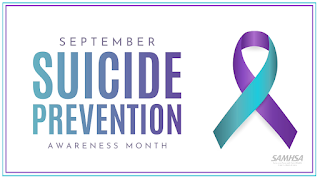Suicide Prevention - Scope of the Problem
September is National Suicide Prevention Month. The Suicide Prevention Lifeline uses #BeThe1To – a message to help spread the word about what we can do to promote healing, help and give hope to save lives and prevent suicide.
Scope of the Problem
A recent Harris Poll national survey found that 81% of respondents believe that suicide prevention needs to be a national priority because of COVID-19. 93% of those surveyed believe that suicide can be prevented and 95% said that they would act if someone closed to them was in crisis. Most (69%) were able to list barriers to doing something, including: not knowing what to say; feeling they don’t have enough knowledge; and not feeling comfortable with the topic. According to the CDC (2020), long-term school closure may lead to an increase in mental health issues as students have fewer opportunities to engage with each other. Adolescents with pre-existing mental illness may be more greatly impacted and not have the same mental health services as available due to school closure.
Suicidal ideation is a major mental health risk among adolescents. Among adolescents ages 12 to 17, suicide is the second leading cause of deaths (The Centers for Disease Control and Prevention, 2016). The CDC also reports an increase of suicidal thoughts and suicide rates among adolescents over time. The 2019 Child Health Report Card highlighted the following:
- The rate of youth suicide has doubled in the previous decade.
- Factors leading to suicidal thoughts include mental health, trauma, persistent stress, family violence, bullying.
- 12% of heterosexual youth reported seriously considering suicide compared to 43% of LGBTQ youth.
- African American youth were twice as likely as white youth to have attempted suicide in the past year and were significantly less likely to get treatment for depression.
- felt sad or hopeless continuously for two weeks or more in the past 12 months
- seriously considered attempting suicide during the past 12 months
- made a suicide plan during the past 12 months
- attempted suicide during the past 12 months
- suicide attempt in the past 12 months resulted in injury that required treatment by nurse or doctor
- Talking about or making plans for suicide
- Expressing hopelessness about the future
- Displaying severe/overwhelming emotional pain or distress
- Showing worrisome behavioral cues or marked changes in behavior, including withdrawal from or change in social connections/situations, changes in sleep (increased or decreased), anger or hostility that seems out of character or out of context, recent increased agitation or irritability
- SAVE provides information on how a pandemic might affect those with certain mental illnesses, as well as Tips for Preventing Suicide During and After a Pandemic.
- National Suicide Prevention Lifeline offers 5 steps to help someone that may be in suicidal crisis. These include ask, keep them safe, be there, help them connect and follow up.
- National Center for the Prevention of Youth Suicide - program of the American Association of Suicidology (AAS), working to change how schools and communities address the issue of suicide among young people.
- The TREVOR Project - leading national organization providing crisis intervention and suicide prevention services to lesbian, gay, bisexual, transgender, and questioning youth.
- U-M Injury Prevention Center Suicide Prevention Resources
- Vibrant Emotional Health’s Safe Space provides interactive coping tools to help users when they need it.
- Crisis Text Line: Text “HOME” or “Start” to 741741 to reach a crisis counselor. This is a free, 24/7 confidential text message service for people in crisis.
- National Suicide Prevention Lifeline: 1-800-273-TALK (8255) - Provides free and confidential emotional support to people in suicidal crisis or emotional distress 24/7.
- The TREVOR Project: Trevor Lifeline: 1-866-488-7386; Trevor Text: Text “START” to 678678




Comments
Post a Comment